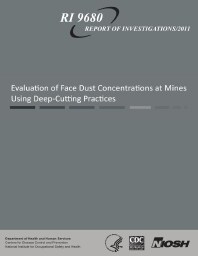Mining Publication: Evaluation of Face Dust Concentrations at Mines Using Deep-Cutting Practices
Original creation date: January 2011
Authors: JD Potts, WR Reed, JF Colinet
NIOSHTIC2 Number: 20038368
Pittsburgh, PA: U.S. Department of Health and Human Services, Public Health Service, Centers for Disease Control and Prevention, National Institute for Occupational Safety and Health, DHHS (NIOSH) Publication No. 2011-131, (RI 9680), 2011 Jan; :1-94
Dust surveys were conducted at six underground mines to determine if deep-cut mining practices expose face workers to higher levels of respirable dust by comparing levels during the first 20 ft of advance (regular-cut depth) during the deep cut to levels during the final 10 to 20 ft of advance (deep-cut depth). The studies were conducted at mines where the Mine Safety and Health Administration (MSHA) had approved an extended curtain setback distance with operation of a flooded-bed scrubber to permit taking deep cuts of up to 40 ft. In general, all of the selected mines exercised good dust control practices by maintaining water sprays, scrubber airflows, proper curtain setback distances and providing sufficient airflow to the active faces. These practices minimized variability in dust levels related to factors other than the depth of cut. To ensure proper scrubber functioning, the scrubber screen was back-flushed before commencing each cut. Both exhausting and blowing face ventilation configurations were studied. All of the operations surveyed for this study were able to successfully implement deep-cutting methods without significantly increasing the dust exposures of face workers during the cutting and bolting cycles. For exhausting face ventilation, field data indicate that scrubber airflow is the most important factor for controlling dust. Clogging of the scrubber screen can result in lower airflows; therefore, the screen must be periodically tapped and back-flushed. Data collected for this study indicate that 20-mesh screens should be cleaned for every 40 ft of advance because 22% of the deep-cut sequences surveyed for this study experienced a 20% to 35% decrease in scrubber airflow over the course of the cut. For blowing face ventilation, field and laboratory data indicate that maintaining a proper curtain-to-scrubber airflow ratio of 1.0 and a curtain setback distance that allows the miner operator to stand at the mouth of the curtain helps control dust. Curtain airflows should be measured before activation of the scrubber regardless of ventilation type (exhausting or blowing) to avoid erroneously overinflating the ratio. The curtain setback variance should be greater than the maximum cutting depth to allow miner operators to maintain their position at the mouth of the curtain when the miner is fully extended into the cut. Greater curtain setback distances associated with deep-cutting methods may result in cuts that do not require ventilation curtain, such as the initial heading developments beyond the last open crosscut. For these cuts, dust levels were generally lower during development of deep cuts when compared to regular cuts. However, adequate ventilation of cuts without ventilation curtain is dependent on a properly functioning scrubber. Dust levels on the bolting faces did not appear to be affected by the longer cycles associated with deep-cut mining practices when curtain airflow was measurable and the curtain was periodically advanced in sync with the bolting machine.

NIOSHTIC2 Number: 20038368
Pittsburgh, PA: U.S. Department of Health and Human Services, Public Health Service, Centers for Disease Control and Prevention, National Institute for Occupational Safety and Health, DHHS (NIOSH) Publication No. 2011-131, (RI 9680), 2011 Jan; :1-94
- Determining the Spatial Variability of Personal Sampler Inlet Locations
- The Effects of Water Spray Placement for Controlling Respirable Dust and Face Methane Concentrations
- Guidelines for the Control and Monitoring of Methane Gas on Continuous Mining Operations
- Impact of Control Parameters on Shearer-Generated Dust Levels
- Jet Fan Ventilation in Very Deep Cuts - A Preliminary Analysis
- Pillar Stability Issues Based on a Survey of Pillar Performance in Underground Limestone Mines
- Respirable Dust
- Safety Culture Assessment in Underground Coal Mining
- Status of a Tapered Element, Oscillation Microbalance-Based Continuous Respirable Coal Mine Dust Monitor
- Technology News 439 - Remote Reset Systems for Continuous Mining Machines Used In Extended Cuts
- Water Infusion of Coalbeds for Methane and Dust Control